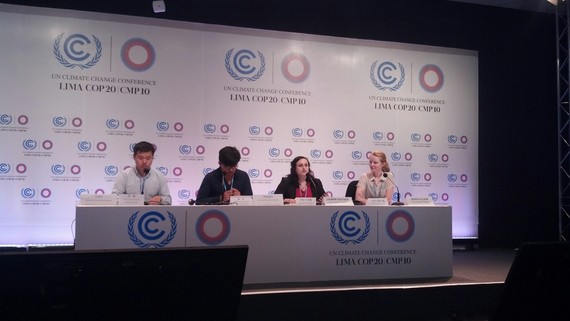Back in November, President Obama took a Beijing stage, shoulder-to-shoulder with Chinese President Xi Jinping, and pretty well shook up the geopolitics of climate change.
The presidents of the two largest polluters of greenhouse gases announced a game-changing climate deal that few saw coming.
Even the most plugged-in climate policy experts--and many Capitol Hill politicians--were stunned.
The bilateral climate agreement--which basically says that the U.S. will cut greenhouse gas emissions by a little over one-quarter (from a baseline in 2005) by 2025, and that China will peak its emissions by 2030--was met with remarkably consistent praise.
Advocates for a strong international climate treaty liked that the bit of diplomacy took away the "waiting for China to act" argument from American naysayers.
And coming as it did in the run-up to the United Nations climate talks in Lima, Peru, the timing of the announcement invigorated the typically sputtering negotiations.
Some of the toughest criticism came from the youngest commentators. A partnership of youth from both the U.S. and China delivered their critique in the form of a joint letter to Presidents Xi and Obama.
"While we support the intent of the recent U.S.-China bilateral agreement, we call on you to be more ambitious in your contributions, ensuring that this is only a starting point as the world moves toward a new climate agreement in 2015," the letter states.
U.S. and Chinese youth present their joint letter in Lima.
There was plenty of praise, too. The youth, representing the Sierra Student Coalition and the China Youth Climate Action Network (CYCAN), wrote that the joint announcement "demonstrates considerable leadership and has inspired us as youth to partner in a similar way. We applaud your commitment to tackle our generation's foremost challenge nationally and internationally."
Lauren Kastner, a recent graduate of the University of Indiana-Bloomington and a member of the Sierra Student Coalition, said in a press conference here in Lima that the Chinese and American youth decided to use their presidents' announcement as an opportunity to collaborate.
Su Zhi of CYCAN echoed the sentiment.
"The whole world has witnessed this first step by U.S. and China, and they are waiting for the lasting actions and implementation," Zhu said. "For our young people, it is really the best opportunity to make our voice heard."
It's not the first time for such collaboration among the nations. American and Chinese youth have worked together regularly since first connecting during the talks in Copenhagen in 2009.
The following year, at COP16 in Cancun, the self-described "joint dialogue" between the two youth delegations continued with a number of workshops with names like "Hello, Nihao, and the Road Forward."
At the time, Al Gore said the youth actions should be a model for the official delegations.
Kastner says that young people have a particularly important role to play, should they choose to accept it. "As youth we have this shared burden that we are now inheriting," Kastner said.
The youth groups are also meeting here in Lima to again share strategies and success stories.
Their joint letter addressed to their national decision-makers includes a bulleted list of rather strict demands. The youth demands make the official pledges, so recently celebrated, feel tepid and uninspired.
After calling upon both governments to work towards a wildly ambitious (but scientifically sound) 1.5 degree Celcius temperature increase target, the students fire some serious demands at each nation.
They "respectfully ask" that China cap coal consumption to meet its goal, and place a hard target of 20% non-fossil fuel energies.
They ask the U.S. to ramp up its pledge to a 50% emissions reduction by 2030, and for a full phase-out of fossil fuels in the power sector.
They ask for the framework of "Common But Differentiated Responsibilities" to be maintained, because, hey, these kids are UN wonks of the highest order, and they'll tell you that CDR (in UN acronym speak) with a strong review process ensures both ambition and equity in the overall goals of whittling down greenhouse gas emissions.
They ask for a lot more strong climate actions. And also for meetings with the negotiators and Parties before COP 21 in Paris next Fall.
When asked how they could be sure the letters would actually reach their respective presidents, Zheng Xu of CYCAN said that they had assurance from the delegation that it would be passed along to President Xi.
"To me, this joint statement of youth between Chinese and U.S. students was a starting point, " said Su of CYCAN. He added that when they talk to the governments, "what our countries should do should be in our hands, as youth. We should shoulder and take the responsibility."
Others at the Lima talks agree.
"Youth are driving the conversation around what is truly needed in the U.S. for a just transition to a renewable energy future," Evan Weber, Executive Director of the U.S. Climate Plan, told DeSmogBlog. "If leaders of the world's two biggest polluters are serious about putting us on the path to a stable climate, they will do well to listen to their young people."
Presidents Obama and Xi have finally shown that the two big polluters can sit down together and produce some kind of climate accord. Their young citizens have stepped up in Lima and shown the leaders how ambitious diplomacy can work.